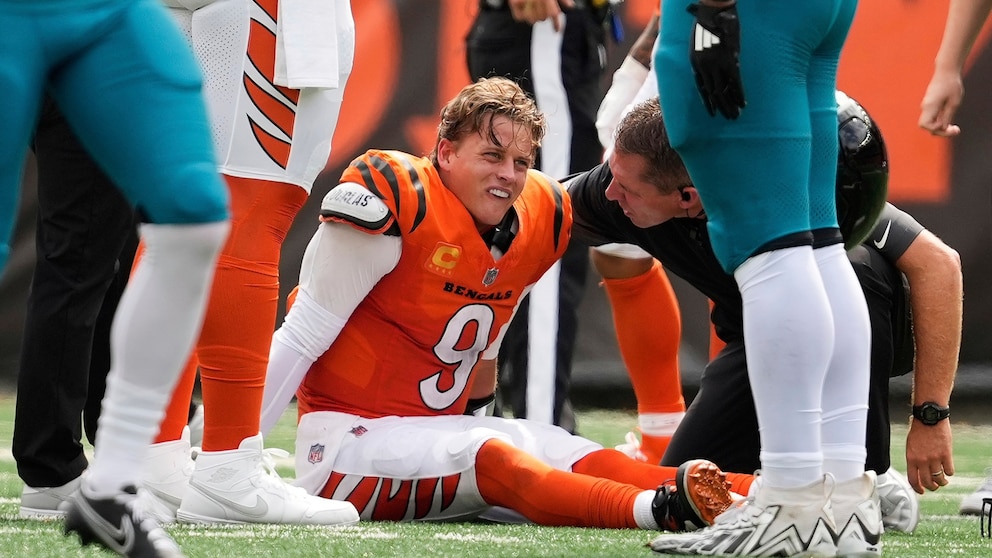What Exactly Is Turf Toe?
Despite its almost casual-sounding name, turf toe is a serious sports injury. It refers to sprains or tears of the ligaments, tendons, and soft tissue around the metatarsophalangeal (MTP) joint—the base of the big toe. According to the Cleveland Clinic, turf toe occurs when the toe is bent upward beyond its normal range while the heel is lifted off the ground. This hyperextension often happens on artificial turf, where players’ shoes stick more firmly to the surface, giving the injury its name.
The injury can be classified into three grades:
-
Grade 1: Mild stretching of tissue, resulting in soreness and minimal swelling.
-
Grade 2: Partial tearing, which causes bruising, tenderness, and limited mobility.
-
Grade 3: Complete tearing of ligaments and soft tissue, often accompanied by dislocation. This is the most severe form and usually requires surgery.
Joe Burrow’s diagnosis—a Grade 3 turf toe with torn ligaments—represents the worst-case scenario. His recovery is expected to take months, not weeks, and it highlights just how debilitating the condition can be.
Why Is Turf Toe So Hard to Recover From?
The big toe might seem small compared to the rest of the body, but it plays a crucial role in balance, acceleration, and push-off strength. Every time an athlete sprints, cuts, or pivots, enormous force is placed on the MTP joint. When that joint is injured, even standing or walking can be painful, let alone competing against elite athletes.
If not given proper time to heal, turf toe can linger, leading to long-term complications such as:
-
Chronic stiffness or pain
-
Bunions or deformities
-
Loss of explosive push-off power
-
Hallux rigidus, a type of arthritis that stiffens the big toe joint
This explains why so many NFL players, even after returning to the field, are never quite the same.
 Cincinnati Bengals quarterback Joe Burrow (9) grimaces aft being sacked by Jacksonville Jaguars defensive tackle Arik Armstead (91) during the first half of an NFL football game, Sept. 14, 2025, in Cincinnati.
Cincinnati Bengals quarterback Joe Burrow (9) grimaces aft being sacked by Jacksonville Jaguars defensive tackle Arik Armstead (91) during the first half of an NFL football game, Sept. 14, 2025, in Cincinnati.
The Long History of Turf Toe in the NFL
Turf toe has been a part of football’s injury history for decades, particularly as artificial playing surfaces became widespread. The grip of cleats on synthetic turf increases the risk of the hyperextension motion that causes the injury.
-
Deion Sanders (1998) – The legendary cornerback and return specialist suffered a turf toe injury with the Cowboys that plagued him for years. His speed, once his greatest weapon, was compromised. Sanders eventually endured so much damage that he later had two toes amputated.
-
Steve McNair (1999–2000) – The Tennessee Titans quarterback battled through turf toe for nearly two seasons. Despite wearing protective boots in practice and even during Super Bowl preparation, McNair never fully escaped its effects until surgery.
-
Davante Adams (2019) – The Packers’ star receiver sustained turf toe early in the season, missing four games. Remarkably, he bounced back without surgery and still earned a Pro Bowl selection.
-
Patrick Mahomes (2021) – The Chiefs quarterback fought through the injury during the playoffs, guiding his team to Super Bowl LV. After the season ended, he underwent surgery to repair the damage.
-
Brock Purdy (2025) – The 49ers quarterback was recently diagnosed with a variant of turf toe, sidelining him for several weeks.
Now, Joe Burrow joins this long list of stars dealing with the painful injury. His timeline for recovery—at least three months—illustrates how severe the damage can be when ligaments are fully torn.
Cincinnati Bengals quarterback Joe Burrow (9) is assisted to the locker room with an injury in the second quarter at Paycor Stadium.
Why Turf Toe Isn’t Going Away
The rise of faster, stronger athletes has only amplified the issue. Today’s NFL demands explosive speed, sudden directional changes, and high-impact collisions—all movements that stress the big toe joint. Artificial turf fields, while convenient and durable, continue to be linked to higher rates of lower-body injuries, turf toe included.
As long as these factors remain part of the game, turf toe will likely continue to haunt NFL players, altering careers and reminding fans that even the smallest joint in the body can have an outsized impact on the sport’s biggest stage.
